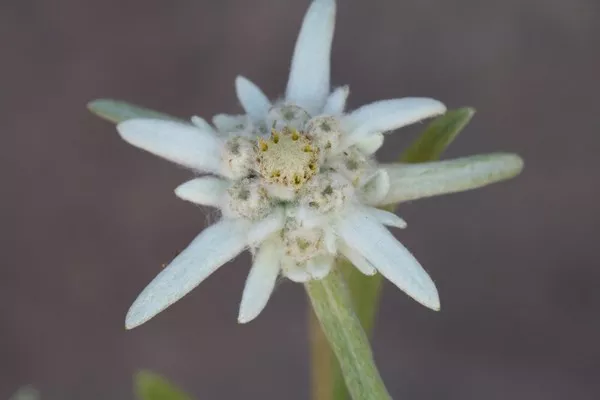The Edelweiss, with its delicate, star-shaped petals and iconic white fuzz, has captured the imaginations of botanists, hikers, and romantics alike. This alpine flower, native to the European Alps, is not just a symbol of rugged beauty but also a testament to nature’s adaptability. In this article, we will delve into the intriguing world of the Edelweiss flower, its physical characteristics, ecological significance and cultural symbolism.
The Appearance of Edelweiss
1. At First Glance
The Edelweiss (Leontopodium nivale) is instantly recognizable due to its distinct appearance. This perennial plant typically stands at 5-20 centimeters tall, bearing a compact cluster of white or yellowish flowers atop a woolly stem. These tiny blossoms are quite small, measuring only about 1-2 centimeters in diameter, but they pack a visual punch that belies their size.
2. Star-Like Petals
The most striking feature of the Edelweiss is its star-shaped, woolly petals. These petals appear in layers, with the central disc consisting of a dense cluster of tiny florets. The outer layer, which forms the “star,” comprises five to six petals. These petals have a velvety texture, owing to the fine hairs that cover them. They are usually a creamy white, though some variants may display a pale yellow hue.
3. Silvery Fuzz
One of the most captivating aspects of the Edelweiss is the silver-white fuzz that blankets its stems and leaves. This fuzzy coat serves a dual purpose: it helps the plant to retain moisture by reducing transpiration, and it offers insulation against the harsh alpine conditions.
Ecological Significance
1. Surviving in Extreme Conditions
The Edelweiss thrives in some of the most challenging environments on Earth – high-altitude alpine regions with thin, rocky soils and extreme temperature fluctuations. Its adaptations to these conditions include the fuzzy exterior, which traps a layer of warm air near the plant’s surface, and a deep taproot that anchors it to the rocky substrate. These adaptations allow the Edelweiss to endure the intense cold and prevent dehydration.
2. Biodiversity and Habitat
In addition to its ecological hardiness, the Edelweiss plays a vital role in its ecosystem. The nectar of its flowers provides sustenance for a variety of pollinators, including butterflies and bees. Furthermore, the dense mats of Edelweiss plants create microhabitats for other alpine species, offering protection from wind and temperature fluctuations.
3. Habitat Restoration
Efforts are also underway to restore and conserve the alpine habitats where Edelweiss thrives. This includes initiatives to combat soil erosion, manage tourism impact, and promote sustainable land use practices to protect the fragile ecosystems where this unique flower grows.
Cultural Symbolism
1. In Literature and Art
The Edelweiss has long been celebrated in literature and art for its ethereal beauty and association with the alpine landscape. It is famously mentioned in the song “Edelweiss” from the musical “The Sound of Music,” where it symbolizes purity and nostalgia. In many alpine cultures, the flower has been a symbol of courage, love, and devotion.
2. A Token of Love
Traditionally, the Edelweiss was presented as a gift to express love and admiration. In some regions, it was even believed that giving an Edelweiss flower to a loved one would bring good luck and protection. The practice of wearing Edelweiss as a boutonniere or including it in bridal bouquets is still common in some Alpine weddings.
Conclusion
The Edelweiss flower, with its star-shaped petals and silver fuzz, represents not only the captivating beauty of the alpine landscape but also the resilience of nature itself. Its adaptations to extreme conditions, cultural symbolism, and ecological significance make it a flower of enduring fascination. As we continue to explore and appreciate the natural world, it is crucial to support conservation efforts that ensure the survival of this iconic alpine treasure for generations to come. The Edelweiss is not just a symbol of beauty; it is a symbol of our responsibility to protect and preserve the delicate wonders of the natural world.


